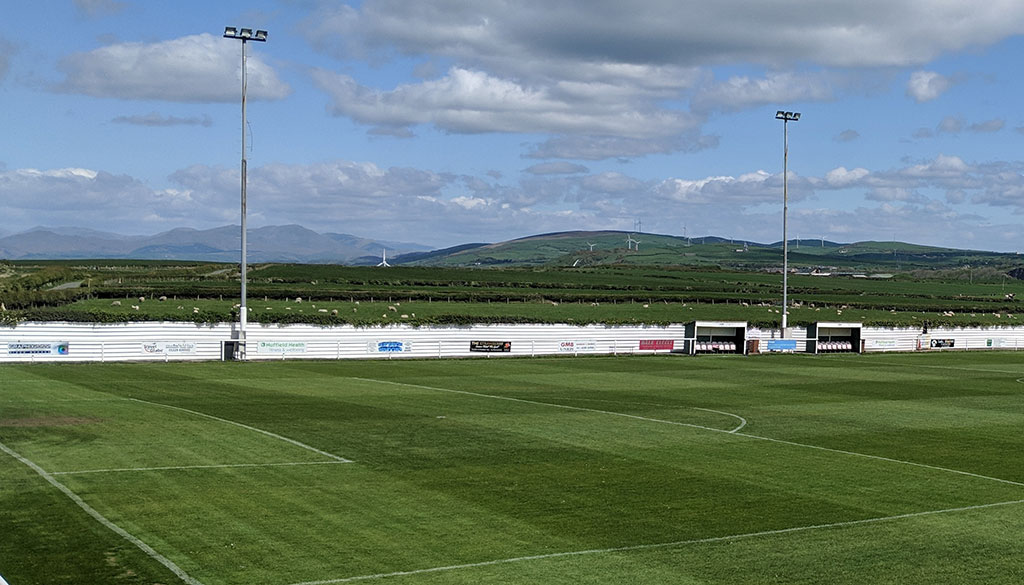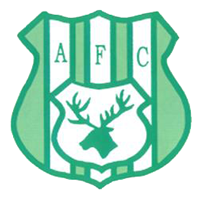
Emblematically Speaking - Holker Old Boys
Tue 6th March 2018 | Holker Old Boys | By Stewart Taylor
Welcome to the world of the landed gentry and, arguably, the most influential family in English history.
A rather grand opening line, perhaps, to an article about a non-league football club based at a modest ground but with spectacular views over some of the most beautiful countryside our green and pleasant land has to offer; but fully justified.
As with a number of articles in this series this digression into English history comes from the presence of a single device on a football club emblem – in this case a stag’s head – but before we look into the detail of quite why a stag is so prominent on this club emblem, let’s sort out the rest of it.
The name of the club and the date of foundation are clear, referencing the link to the formation of the club as an under 16s side from Old Boys of the then Holker Central Secondary School on Holker Street in Barrow-in-Furness.
The green and white vertical stripes on the larger shield refer, not surprisingly, to the playing colours of the club. The lettering is in a gold colour which, in itself, is of interest.
The use of gold as a colour in heraldry could be seen as representing a number of different attributes relating to the most noble of metals. It may well be in this case that the use of gold lettering refers to nobility itself which would be entirely relevant as we will see.
We have seen previously in this series that what we call a shield is often better described in heraldic terms as an escutcheon. There is a specific design recognised in heraldry and given the name inescutcheon.
This refers to what we may more readily recognise as a shield within a shield and that’s exactly what we see here. The use of an inescutcheon can have a number of meanings including the recognition of the family of a wife of a nobleman, particularly where some sort of heredity is involved.
Here it is perhaps used simply to highlight the charge on the shield and, thus, the significance of that charge – in this case, a stag’s head.
A stag is depicted on the Barrow-in-Furness coat of arms granted in 1876 and continued by Barrow Borough Council in 1975.The stag’s head is taken from the crest of the Duke of Devonshire, who was a principal landowner in the area and here we get to the point – about time I hear you say – about the most influential family in English history – the Cavendish family.
Perhaps the name of the family doesn’t come immediately to mind but if we were to refer to the peerage title the Duke of Devonshire then that might ring a couple of bells. The opening line to this article was rather bold as the Marquesses of Salisbury and the Earls of Derby may wish to lay claim to the title of “the most influential family in English history” but that need not concern us here.
It is, as usual, rather beyond the scope of this series of articles to go on, seemingly interminably, about the history of a particular family but I am tempted as the history of the Cavendish family is truly fascinating. Nevertheless, I won’t except to describe their residence of many centuries.
Holker Hall is a truly magnificent stately home just to the south west of Cartmel. The building dates from the 16th century and sections have been added since. It stands in grounds of around 80 hectares (around 200 acres), the site being originally owned by Cartmel Priory, and is grade II* listed.
It is the current home of the Cavendish family although the current Duke of Devonshire lives at Chatsworth House in Derbyshire – the structure of the aristocracy in this country is a mystery to most! The Hall is open to the public and many thousands of visitors flock to the hall every year.
It lies just less than 20 miles from the Rakesmoor Lane home of Holker Old Boys close to Grange-over-Sands and is well worth a visit but give yourself plenty of time if you do – there’s a lot to see.
The name Holker and references to the Cavendish family abound in the area. William Cavendish, 7th Duke of Devonshire, was one of the investors in the Furness Railway which brought the industrial revolution to this geographically rather isolated part of the country.
The largest of the docks in the Port of Barrow is known as Cavendish Dock. This dock was used as an airship construction facility at the beginning of the last century. Many followers of football, and particularly the non-League game, will be aware already that Barrow FC play their home matches at the Holker Street Stadium in the town.
The significance of the Cavendish family to this part of England cannot be overestimated as, along with the Dukes of Buccleuch, the family owned huge tracts of land were instrumental in the development of the area.
It is fitting, therefore, that Holker Old Boys AFC recognise that contribution by making a stag’s head the focal point of their club emblem.
 Emblematically Speaking - Holker Old Boys
Emblematically Speaking - Holker Old Boys
Tue 6th March 2018 | Holker Old Boys
By Stewart Taylor

Welcome to the world of the landed gentry and, arguably, the most influential family in English history.
A rather grand opening line, perhaps, to an article about a non-league football club based at a modest ground but with spectacular views over some of the most beautiful countryside our green and pleasant land has to offer; but fully justified.
As with a number of articles in this series this digression into English history comes from the presence of a single device on a football club emblem – in this case a stag’s head – but before we look into the detail of quite why a stag is so prominent on this club emblem, let’s sort out the rest of it.
The name of the club and the date of foundation are clear, referencing the link to the formation of the club as an under 16s side from Old Boys of the then Holker Central Secondary School on Holker Street in Barrow-in-Furness.
The green and white vertical stripes on the larger shield refer, not surprisingly, to the playing colours of the club. The lettering is in a gold colour which, in itself, is of interest.
The use of gold as a colour in heraldry could be seen as representing a number of different attributes relating to the most noble of metals. It may well be in this case that the use of gold lettering refers to nobility itself which would be entirely relevant as we will see.
We have seen previously in this series that what we call a shield is often better described in heraldic terms as an escutcheon. There is a specific design recognised in heraldry and given the name inescutcheon.
This refers to what we may more readily recognise as a shield within a shield and that’s exactly what we see here. The use of an inescutcheon can have a number of meanings including the recognition of the family of a wife of a nobleman, particularly where some sort of heredity is involved.
Here it is perhaps used simply to highlight the charge on the shield and, thus, the significance of that charge – in this case, a stag’s head.
A stag is depicted on the Barrow-in-Furness coat of arms granted in 1876 and continued by Barrow Borough Council in 1975.The stag’s head is taken from the crest of the Duke of Devonshire, who was a principal landowner in the area and here we get to the point – about time I hear you say – about the most influential family in English history – the Cavendish family.
Perhaps the name of the family doesn’t come immediately to mind but if we were to refer to the peerage title the Duke of Devonshire then that might ring a couple of bells. The opening line to this article was rather bold as the Marquesses of Salisbury and the Earls of Derby may wish to lay claim to the title of “the most influential family in English history” but that need not concern us here.
It is, as usual, rather beyond the scope of this series of articles to go on, seemingly interminably, about the history of a particular family but I am tempted as the history of the Cavendish family is truly fascinating. Nevertheless, I won’t except to describe their residence of many centuries.
Holker Hall is a truly magnificent stately home just to the south west of Cartmel. The building dates from the 16th century and sections have been added since. It stands in grounds of around 80 hectares (around 200 acres), the site being originally owned by Cartmel Priory, and is grade II* listed.
It is the current home of the Cavendish family although the current Duke of Devonshire lives at Chatsworth House in Derbyshire – the structure of the aristocracy in this country is a mystery to most! The Hall is open to the public and many thousands of visitors flock to the hall every year.
It lies just less than 20 miles from the Rakesmoor Lane home of Holker Old Boys close to Grange-over-Sands and is well worth a visit but give yourself plenty of time if you do – there’s a lot to see.
The name Holker and references to the Cavendish family abound in the area. William Cavendish, 7th Duke of Devonshire, was one of the investors in the Furness Railway which brought the industrial revolution to this geographically rather isolated part of the country.
The largest of the docks in the Port of Barrow is known as Cavendish Dock. This dock was used as an airship construction facility at the beginning of the last century. Many followers of football, and particularly the non-League game, will be aware already that Barrow FC play their home matches at the Holker Street Stadium in the town.
The significance of the Cavendish family to this part of England cannot be overestimated as, along with the Dukes of Buccleuch, the family owned huge tracts of land were instrumental in the development of the area.
It is fitting, therefore, that Holker Old Boys AFC recognise that contribution by making a stag’s head the focal point of their club emblem.


